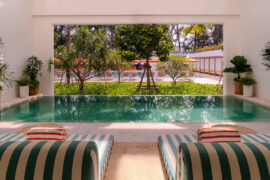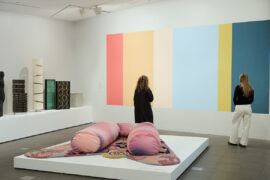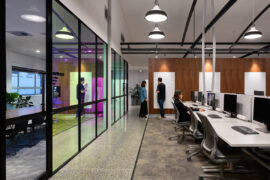NBRS Architecture have transformed one of the oldest structures on Macquarie University’s campus – the Faculty of Science & Engineering’s Mitchell building – to create an energy and space efficient contemporary workspace that encourages collaboration whilst respecting the historical, social and aesthetic significance of the building.
“The Mitchell building at Macquarie University was built in the mid 1960s; it’s one of the oldest buildings on the Macquarie University site,” says Andrew Duffin, design director at NBRS.
“Before we got there it was what you’d expect of an old academic building – brick walls, single corridors with little rooms, quite dark, dusty, cold and academic. It hadn’t changed for 40 or 50 years.”
Duffin and the team at NBRS Architecture saw the age of the building as no obstacle, however. Knocking down the building and replacing it with something ultra-modern was out of the question. Instead, they worked with the existing structure, reinvigorating the bones and subtly bringing the Mitchell building into modern day.
Perhaps the biggest transformation for the building is the new atrium – a three-storey glass thoroughfare which connects the Mitchell building to the adjacent E7B building. Bathed in natural light and with a view to the main quadrangle, the atrium replaces a space that was once a cold, dark wind-tunnel.
The addition also improves street presence and creates a sense of arrival into the building. “Actually, my favourite element of the project would be the steel-framed entry portals at the ground level of the atrium,” says Duffin. “They identify a sense of navigation through architecture. There’s no need for signage, you just know where the front doors are (there are three). It’s not a massive element of the project, but that’s a detail I really like.”
The atrium features a polished concrete flooring, which represents the transition from outdoors to indoors, and vice versa. The use of simple and honest materials such as this also marries the contemporary addition with the existing building, which is comprised clinker brick and exposed concrete. “Our job was not to fight the natural patina, but work with it,” Duffin says.
Modern colour pops punctuate the main building, notably a bright red, which highlights the building’s core. The core was originally positioned within the structure’s footprint, but NBRS Architecture decided to pull it out and run it up the outside of the building in order to save precious floor space. The standout red that coats the core now hugs the side of the building, clearly highlighting amenities for visitors and students.
Sustainability was also key within the project, and in order to help support the University’s One Planet ecological footprint target, the existing façade was retained, significantly reducing the job’s carbon impact, while high performance glazing was used to reduce solar heat gain, and natural ventilation was maximised throughout.
“This renewal is a perfect example of the benefits of retrofitting rather than rebuilding. By unlocking the potential of the existing building, we have provided a more sustainable workspace for the next generation of academics,” says Duffin.
“The building had already lasted around 50 years, so to give it another life as opposed to knocking it down is a great thing. Who knows, maybe there’s another 50 years in it.”
.
INDESIGN is on instagram
Follow @indesignlive
A searchable and comprehensive guide for specifying leading products and their suppliers
Keep up to date with the latest and greatest from our industry BFF's!

A longstanding partnership turns a historic city into a hub for emerging talent

With experience across fashion, styling and interiors, Nicholas Gilbert launches Studio Nicholas with a mission to elevate Australian design on the world stage — and to champion a more rigorous, professional future for the industry.

Opening in October 2025, The Standard, Pattaya Na Jomtien brings together ONION, DIN Studio, Studio Lupine and Verena Haller to create a sculptural modernist retreat where art, architecture and coastal culture meet.

At the NGV’s Making Good: Redesigning the Everyday, design becomes a force for repair. From algae-based vinyl to mycelium earplugs, the exhibition proves that rethinking the ordinary can reshape our collective future.
The internet never sleeps! Here's the stuff you might have missed

Foster + Partners has recently delivered two significant projects in Sydney, working across both commercial and public transport infrastructure.

Architectus’ new headquarters for Q-CTRL addresses complex technical requirements while creating an enjoyable place to work.